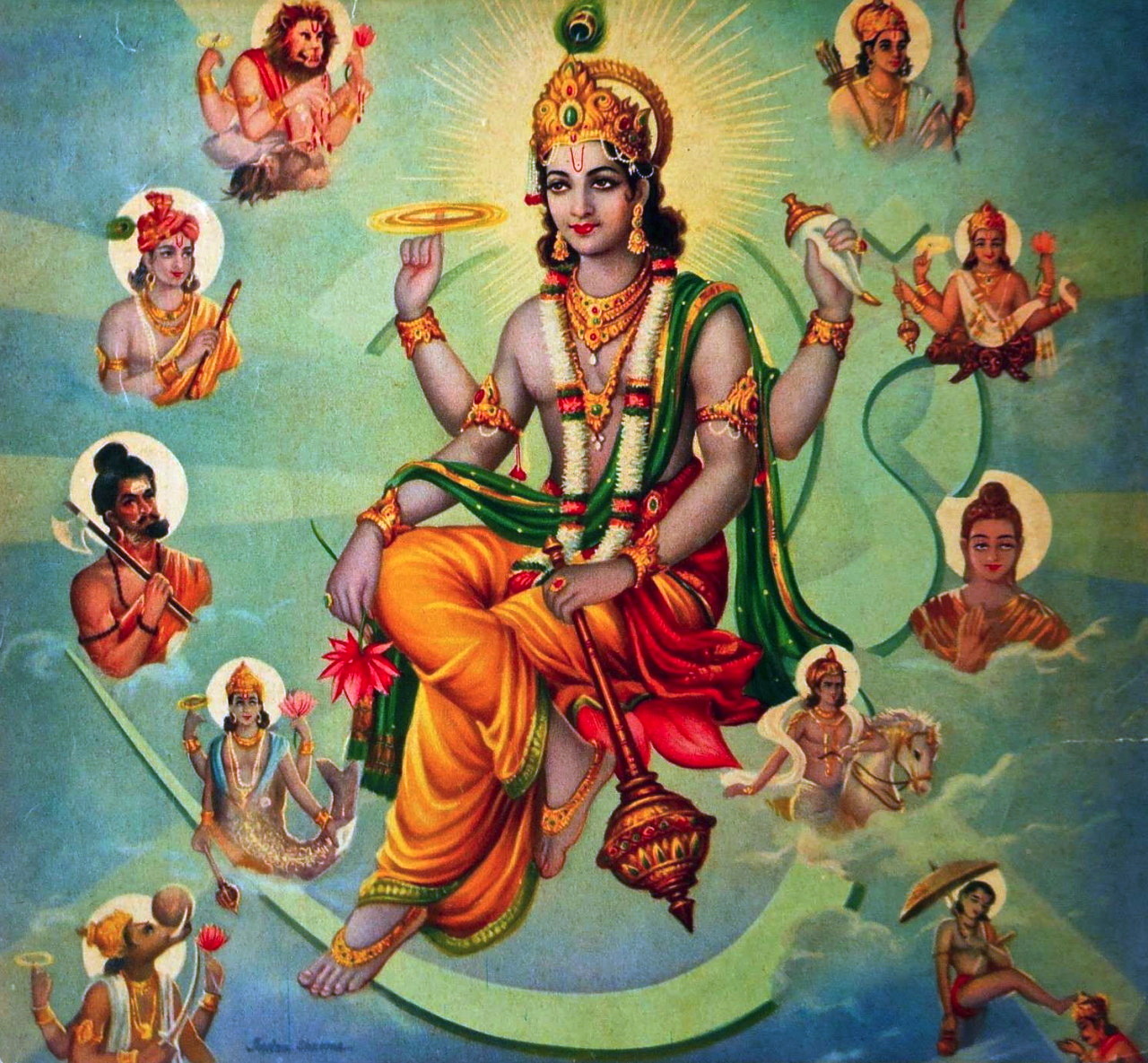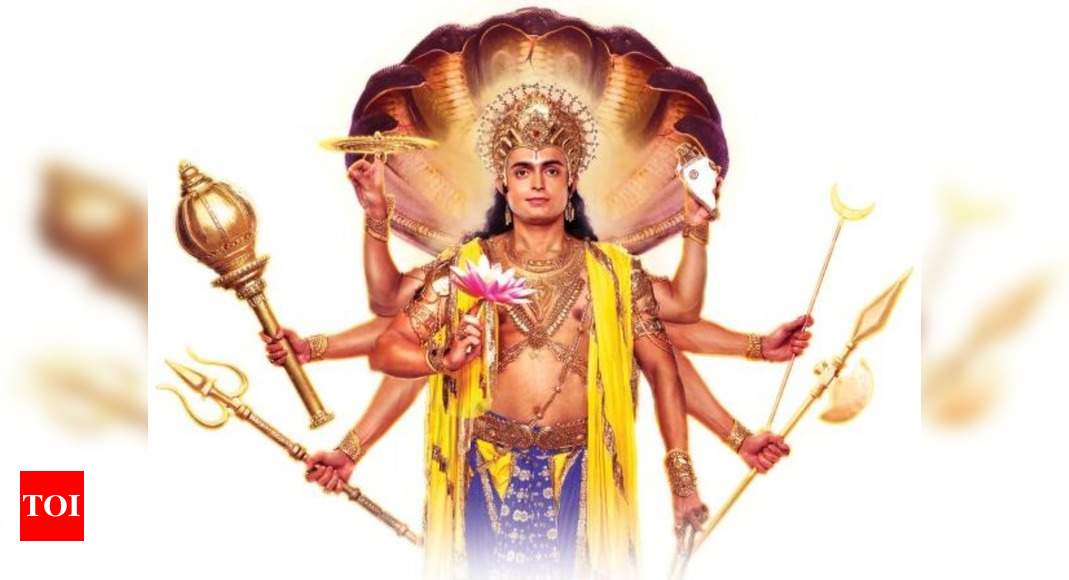
The grandson of Prahlada, Bali, with devotion and penance was able to defeat Indra, the god of firmament. He disemboweled Hiranyakashipu, and brought an end to the persecution of human beings including his devotee Prahlada. Vishnu descended as an anthropomorphic incarnation, with the body of a man and head and claws of a lion. The boy was protected by the god and could not be killed, thus being saved by the several attempts of getting harmed. Hiranyakashipu persecuted everyone for their religious beliefs including his son who was a Vishnu follower.
4 - Narasimha :- The half-man/half-lion Avatar. Varaha carried the Earth out of the ocean between his tusks and restored it to its place in the universe. The battle between Varaha and Hiranyaksha is believed to have lasted for a thousand years, which the former finally won. Varaha appeared to defeat Hiranyaksha, who had taken the Earth, or Bhumi, and carried it to the bottom of what is described as the cosmic ocean (much like in ether theory) in the story. In their first demonic birth they become Hiranyaksha and Hiranyakashipu. Jaya and his brother Vijaya are cursed by the sage Sanaka when they stop him from seeing Vishnu, and will be reborn three times as demons ( asura) to be killed by Vishnu. When the devas and asuras were churning the Ocean of milk in order to get Amrita, the nectar of immortality, the mount Mandara they were using as the churning shaft started to sink and Vishnu took the form of a tortoise to bear the weight of the mountain. 2 - Kurma :- The Giant Tortoise Avatar. When the deluge ( Pralaya) comes, Vishnu appears as a great fish with a horn, to which Manu ties the boat, which leads them into safety. Vishnu informs Manu of the coming destruction of the world, by means of fires and floods, and directs Manu to collect "all creatures of the world" and keep them safe on a boat built by the gods. Eventually, he releases it into the ocean, realizing it is Lord Vishnu himself. Manu keeps the fish to give it a home, but the fish keeps expanding, which breaks Manu's pride about his wealth. The fish asks Manu if his riches and power was enough to give the fish a nice home. King Vaivasvata Manu finds a little fish in the palm of his hands when performing the tarpana (water-offering). Kalki (prophesied 10th avatar who ends the Kali Yuga)ġst to 5th of the Dashavatars on Udupi temple gopuram, Karnataka. The following table summarises the position of avatars within the Dashavatara in many but not all traditions: Position Though no list can be uncontroversially presented as standard, the "most accepted list found in Puranas and other texts is Krishna, Buddha." The latter version is followed by some Vaishnavas who do not accept the Buddha as an incarnation of Vishnu. Some lists mention Krishna as the eighth avatar and the Buddha as the ninth avatar, while others – such as the Yatindramatadipika, a 17th-century summary of Srivaisnava doctrine – give Balarama as the eighth avatar and Krishna as the ninth. Various versions of the list of Vishnu's avatars exist, varying per region and tradition. The Dashavatara is a list of the ten complete (i.e. 'Avatara' (अवतार) means 'incarnation' Īccording to Swami Parmeshwaranand, although the avatars of Vishnu are countless in number and include hermits, Manus, sons of Manus, and other Devas (gods), due to the curse of a Rishi called Bhrgu most are only partial (i.e. 
'Dashavatara' or ' daśāvatāra' (दशावतार) means 'ten avatars' or 'ten incarnations': The order of the ancient concept of Dashavataras has also been interpreted to be reflective of modern Darwinian evolution, as a description of the evolution of consciousness. All avatars have appeared except one Kalki, who will appear at the end of the Kali Yuga. Some traditions include a regional deity such as Vithoba or Jagannath in penultimate position, replacing Krishna or Buddha. In traditions that omit Krishna, he often replaces Vishnu as the source of all avatars.

Though no list can be uncontroversially presented as standard, the "most accepted list found in Puranas and other texts is Krishna, Buddha." Most draw from the following set of figures, in this order: Matsya Kurma Varaha Narasimha Vamana Parashurama Rama Krishna or Balarama Buddha or Krishna and Kalki. The list of included avatars varies across sects and regions, particularly in respect to the inclusion of Balarama (brother of Krishna) or Gautama Buddha. The word Dashavatara derives from daśa, meaning 'ten', and avatar ( avatāra), roughly equivalent to ' incarnation'. Vishnu is said to descend in the form of an avatar to restore cosmic order.

The Dashavatara ( / ˌ d ə ʃ ɑː v ˈ t ɑː r/ Sanskrit: दशावतार, daśāvatāra) are the ten primary avatars of Vishnu, a principal Hindu god.






 0 kommentar(er)
0 kommentar(er)
